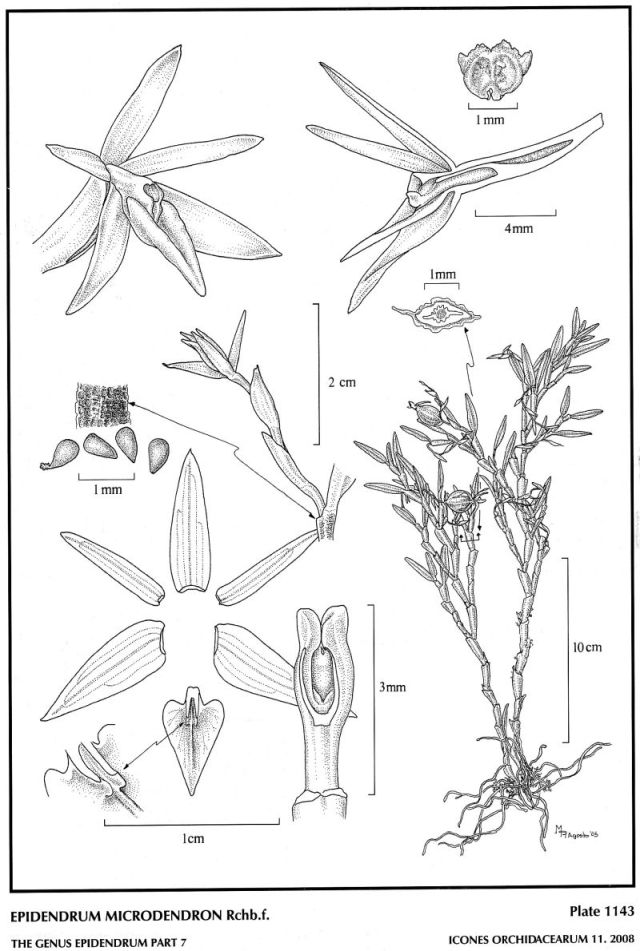

Epidendrum microdendron Rchb.f. 1866 GROUP Ramosum SUBGROUP Rugosum
TYPE Drawing by © Jimenez and The AMO Herbaria Website
Specimen by © Standly and Epidendra Webpage





Common Name The Small Tree Epidendrum
Flower Size .6" [1.5 cm]
Found in Costa Rica and Panama in rainforests, cloud forest and oak forests on the edge of the paramo at elevations of 1500 to 3200 meters as a small sized, cool to cold growing epiphyte with branching, cane-like, laterally compressed, ancipitose, two-winged, main branch intermediate in length, secondary branches somewhat shorter, floral branches giving rise in turn to new branches from subapical internodes and carrying throughout the main stem and branches, deciduous on older stems, persistent on branches, 5 to 12 on the main stem, 3 to 6 on the flowering branches, narrowly lanceolate, bilobed, subcoriaceous, rugose, dorsally carinate leaves that blooms in the spring through fall on a terminal, racemose, distichous, erect, short, two-winged, rachis filiform, flexuous inflorescence with as long as to longer than the ovary, tubular below, ovate, acute floral bracts and carrying 2 to 4, simultaneously opening, yellowish green flowers with the lip always facing the rachis.
The strongly compressed stem with the principal sinuous, the scarsely verrucose sheaths, the lanceolate, bilobed apically leaves and the non-imbricating longer than the ovary floral bracts and the separate flowers with a heart-shaped lip distinguish this species.
"Epidendrum mícrodendron Rchb,f. belongs to the GROUP Ramosum which is characterized by the monopodial, branching stems, the spike-like, distichous inflorescence, and the single callus, and the SUBGROUP Rugosum which has branching habit with few-flowered inflorescences from short, secondary stems, the leaf-sheaths rugose, The species can be recognized by its intermediate, much-branched, bush-like appearance, with laterally compressed, ancipitose, two-winged stems, generally 2-flowered inflorescence, the rachis filiform, the leaves of the main stem 1 to 1.4" [2.5 to 3,5 cm] long, the lanceolate petals, and the acuminate lip, It is very similar to the more seldom seen Epídendrum elcimeyae Hágsater & Carda-Cruz, which is vegetatively very similar but has shorter leaves on the main stem, up to .8" [20 mm] long, narrowly oblong petals and shorter, acute, triangular-cordate lip, Vegetatively E, cordiforme C.Schweinf. is similar, but the stems are terete, and the more membranaceous flowers have a semiorbicular, apiculate lip and spatulate-oblanceolate petals, Epidendrum orthodontum Hágsater & Sánchez has much more robust plants, terete stems, and lhe 4 to 6 flowered inflorescence with thicker, two-winged rachis, and the column with a apical upright tooth." Hagsater etal 2008
Synonyms Epidendrum fundii Ames 1925
References W3 Tropicos, Kew Monocot list , IPNI ; The Genus Epidendrum Ames 1936; The Orchids of Panama L.O. Williams & P Allen 1946; Ceiba Vol 5 No 1 L O Williams 1956 as E fundi; Ceiba Vol 5 No 1 L O Williams 1956; Icones Orchidacearum 3 Plate 329 Hagsater & Sanchez 1999 see recognition section;Manual de las Plantas de Costa Rica Vol 3 Hammel, Grayum, Herrera and Zamora 2003; Icones Orchidacearum 9 Plate 922 Hagsater 2007 see recognition section; Icones Orchidacearum 11 Plate 1143 Hagsater 2008 drawing fide; Orquideas, Tesoro de Colombia Vol 2 Ortiz & Uribe 2017;
--------------------------------------------------------------------------------------------------------------------------
--------------------------------------------------------------------------------